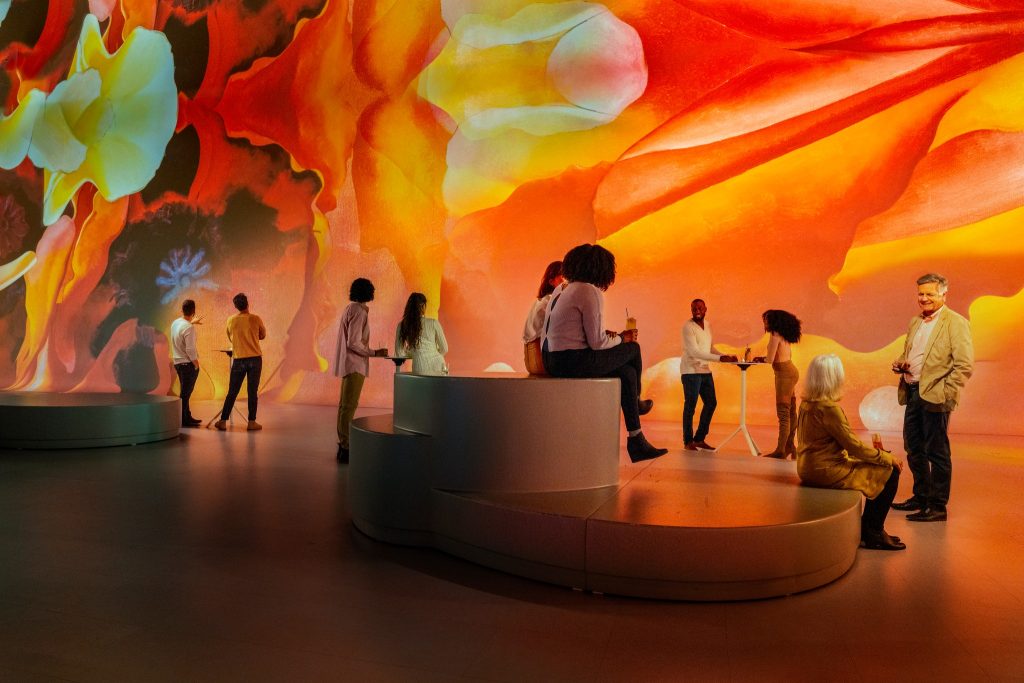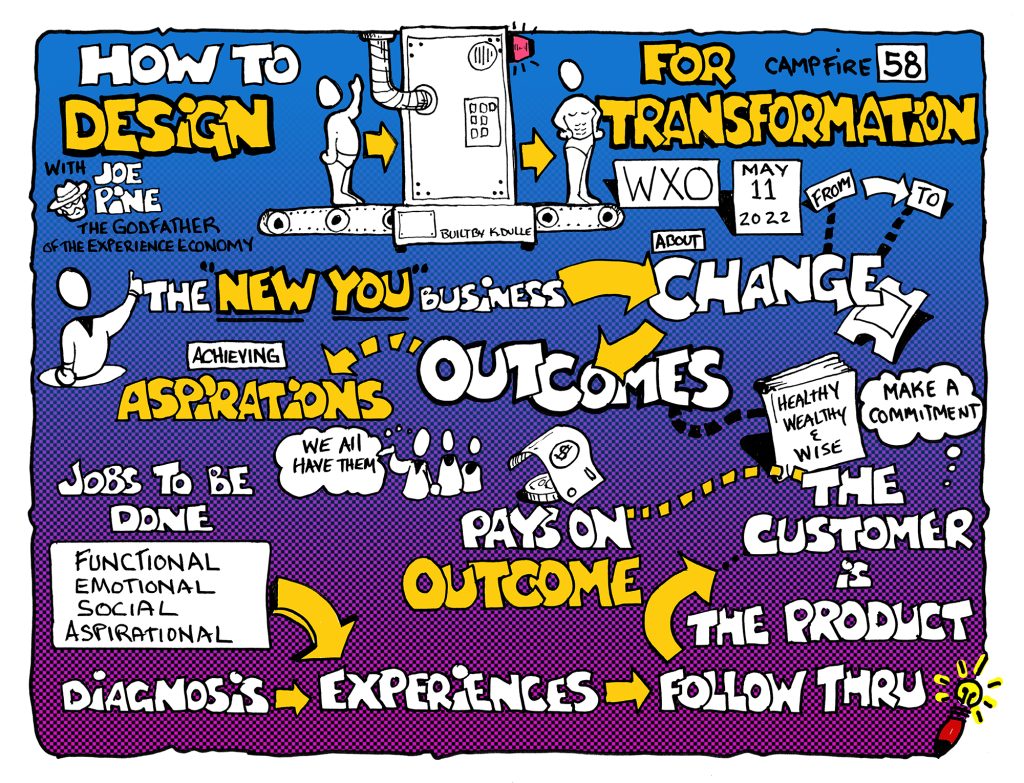Commodities. Goods. Services. Experiences. So, what’s next?
According to our very own Experience Economy Godfather, Joe Pine, the answer is clear: the next stage of economic progression will be transformations.
Many businesses are naturally already in the transformation business – what Pine calls “The New You business” in a recent article for the Harvard Business Review. Think fitness or healthcare centres, where you can transform your body. Universities or coaching sessions, where you can transform your mind. Or management consultants of all stripes, whose sole purpose is to transform companies.
However, most other businesses could greatly benefit by thinking how they could elevate their offerings to the transformation level. And as experience designers, it’s our role to consider how we can create experiences that enable our customers / participants / guests / audiences to attain their aspirations – not only in the short term, but for the rest of their lives.
Here’s what Pine had to say about how to design for aspirational jobs to be done and stride into the New You business like a boss.
The Difference Between Experiences And Transformations

When we look at the progression of economic value, commodities and goods sit at the bottom, services in the middle, and experiences and transformations at the top. (For more on how experiences are different to services, check out Campfire 4: The Difference Between Services And Experiences.)
As we progress along the scale, it become less commoditised and more customised. Customisation is the antidote to commoditisation. Experiences are the raw material to guide people to change. Therefore transformation is something that is built on top of experiences to help people achieve their personal aspirations.
“As you move up in each level, you need to customize every time. Commoditisation is something that you can mass produce more and more, but as you customize more and more it implies that you’re actually creating more variants over time. That also implies that how you evaluate success is going to be more personalized.”
Mike Lai
In the 2020 re-release of Pine and Joe Gilmour’s seminal book The Experience Economy, they outlined that experiences must have five qualities:
- Robust
- Personal
- Cohesive
- Dramatic
- Transformative
To achieve transformation, though, we need a helping hand. And this is where the opportunity for businesses and experience designers lies.
“Even though we’re all filled with hopes, aims, and ambitions, significant change is incredibly hard to accomplish on our own. Enterprises should recognize the economic opportunity offered by the transformation business, in which they partner with consumers to improve some fundamental aspect of their lives—to achieve a ‘new you’.”
Joe Pine
New You Businesses In Action

Pine outlined several examples of businesses that offer transformation as part of what they do.
Take an education setting. When you attend a university, you’re not there for the physical books (the goods) or the contact time with your professors (the service). The experience of being in a lecture hall is part of it – but ultimately you’re there to increase your skills and learning potential, and probably get a different job that might earn you more money or fulfilment. This is a different mindset and economic offering – something that the London Business School recognises.
“We’re not in the education business. We’re in the transformation business. We expect everyone who participates in the program – whether it’s for three days or for two years – to be transformed by the experience.”
John Quelch, Dean, London Business School
If we look at aids to help people stop smoking, people aren’t buying the product in and of itself – they’re buying the potential to be transformed from smoker to non-smoker. However, GSK – the makers of Nicorette patches – found that the success rate from buying their product was really low. So to help their customers actually achieve their aspiration, they created a programme called MyQuit to provide ongoing support and guidance. As a result, users were 56% more likely to undergo the transformation they desired.
Flavorman is a company of “beverage consultants” who are experts in the brewing and liquor industry. When the craft beer business took off in the USA, they created a “Moonshine University” where students can learn how to get into the spirits business, charging attendees thousands of dollars for each five-day course. As a result, many of their graduates become brewers – and in turn Flavorman clients, resulting in long-term repeat business.
The Transformational Travel Council represents one of the largest growing areas of the travel industry, as people now want to become a different person as a result of having visited a new place. And the food store Eataly doesn’t just sell commodities and goods, or even just provide a great experience with its in-store restaurants – it also offers a cooking school so customers can transform into an Italian chef.
How To Unearth Your Customers’ Aspirations

Whatever business you’re in or experience you’re designing, your customers will have aspirations. The idea of “kaizen” – continuous improvement – is central to human behaviour. So how can you make a diagnosis to discover what really matters to your customers, and therefore help them get there?
To do this, you need to first ascertain what jobs your customers want to be done. These can generally be split into four types:
- Functional: the clear, functional goal to accomplish, for example nailing a hammer into a wall.
- Emotional: the feeling to heighten or diminish, which can often be achieved through storytelling.
- Social: the perceived concern about how they interact with others and the relationships they have.
- Aspirational: the process of becoming or being.
To understand this last category, we need to ask questions. Pine uses the “Five Whys” framework. The first time you ask someone why they want something, the answer will rarely be the root cause – it’s just a symptom. Pine gave the example of a client who was going back to school to get her MBA. Upon first asking why, she replied that she wanted to learn more; but after repeated asking, it turned out the “real why” was that she wanted to improve people’s financial conditions. This also mirrors the technique used by the Transformational Travel Council:
“We keep asking why to uncover their true motivations: why are you feeling burned out? What experience of life do you want to have? We have a framework in place, but it’s also very intuitive and depends on the individual, because it’s critical to meet them where they are.”
Jake Haupert
Your audience might not be fully aware of the transformation that they actually need. Perhaps we need different categories of transformation: aspirational, and unexpected.
“I look at my business in terms of story and the customer being the hero. The point is that they undergo a transformation – but there’s a difference between the transformation that they’re seeking, and the transformation that they need.”
Anthony Weller
(Think of Campfires 56 & 57: Trojan Horses And Finding Meaning In Unlikely Places, where we discussed the power of providing an unexpected transformation on top of meeting the expectations of the experience. When the unexpected occurs, the effects ripple out.)
We’re also all human – and there are certain things that all humans seek, like autonomy, safety, status and connection. We can therefore look for patterns to help us identify what transformation might be appropriate.
Transformation Is On Top Of The Stack Of Economic Value

The progression of economic value isn’t linear: it’s a stack. Goods are made on top of commodities, services on top of goods, experiences on top of services, and transformations on top of experiences.
Therefore experience designers should ask how they can integrate services, experiences and goods together to create a solution that affects the outcome people want. Transformation is rarely one life-transforming experience, but instead an ongoing process.
Jasmin Jodry is working on an environmental experience called Illuminarium that aims to turn people into eventual rainforest lovers, or even activists.
“At the moment we just charge for tickets – but how could we charge for that transformation too?”
Jasmin Jodry
Perhaps the answer lies, as Pine suggested, in finding other partners that are trying to reach the same transformation and integrating solutions with them. Rather than a road to Damascus experience that takes place in the moment, you become part of a gradual progression.
This can also help us to avoid what Doug Steel calls “transformational overload”. We don’t want to live in a land where even our breakfast cereal promises to transform us – but it can be part of smaller micro-transformations that layer up to one bigger transformation, like living a healthier lifestyle.
Don’t Forget Your Follow-Through

Pine borrows terminology from the medical field to help identify how we can guide people through the stages and towards this integration.
Stage 1: Diagnosis. Who is this person? What are their aspirations? Who are they today, and who do they want to become?
Stage 2: Experiences. Design the set of experiences to go alongside goods and services that will help them achieve this aspiration.
Stage 3: Follow-Through. Transformation is rarely all in one moment, or a gradual increase – it goes up and down. Therefore when they achieve their aspirations, your job as an experience designer isn’t done – you need to follow through to ensure that the transformation takes hold. When you do this, it leads to them achieving their aspirations on a deeper level and developing a relationship with you as a lifelong guide.
Pine used the example of a weight-loss program called Profile. In addition to meeting with clients to understand why they want to lose weight (the diagnosis) and committing them to the process (the experience), they also have weekly sessions with a coach to ensure they’re on target (the follow-through).
Charge For The Outcomes You Deliver

When you’re in the transformation business, the customer is the product. It doesn’t matter how engaging your experience is unless they get the specific outcome they’re looking for. Services exist outside of us, experiences exist inside of us, and transformations change us from the inside out.
Given that you are what you charge for – see Campfire 35: Time Is Money, Or A New Way To Measure ROX for more – when it comes to transformations you shouldn’t just charge for time well spent, but also for time well invested.
Purdue University operates on an income share agreement dependent on their customers’ outcome – they give out loans that graduates only have to repay when they get a job in a relevant field. And at experience design business Starizon Studio, they offer a transformation guarantee whereby 25% of their fees are at their client’s discretion, depending on whether they feel they got the outcome they wanted.
Lori Buscaglia wondered how you could charge under this framework if someone doesn’t have the desired transformation, but perhaps due to them having the wrong mindset as opposed to you providing a bad experience.
Prior to the first stage of diagnosis, Pine suggested a “stage zero” to help counter this: triage.
“Is this person capable of the transformation they want? Or do they have the commitment? If not, you may not agree to set a price according to the outcome. Or perhaps you would present them with another experience they have to go through to gain that commitment. You can lead a horse to water, but you can’t make it drink.”
Joe Pine
As experience designers, we set the stage for transformation, but we can’t elicit it from people.
“I think of transformation in terms of building autonomy, skills and abilities. Autonomy is one of the primary agents of human happiness, where the consumer owns the means of production through the marketplace.”
Ben Hunnicutt
Handle With Care: Our Responsibility As Transformers

As transformations can be lifelong and take place on a deeper level, changing us from the inside out, experience designers have a responsibility to manage their customers’ transformations with care.
“We’re only ever the product of our experiences, so people are changed by them whether we intend it or not. Just like banks have a fiduciary responsibility to manage your money, as experience stagers, we need to manage our experiences in a way that has positive edifying effects, not negative deleterious effects.”
Joe Pine
There are issues of wellbeing at stake when we look at transformation in contexts other than entertainment – for example, someone might say they want to lose weight to be healthier, but it might actually be to escape being bullied. If they lose the weight but the bullying doesn’t stop, the transformation will fail and it can even be harmful. Perhaps we also need to make sure we’re not selling transformation as a way to fix “broken” people, but as an aspiration to help them achieve their dreams.
As ever, our role as experience designers isn’t to tell people how to feel or how to change, but to create the conditions within which they can feel it for themselves.
“A lot of people argue that we shouldn’t use the term experience design, because we’re not actively designing experiences; we’re designing for people to have experiences, because experiences happen within people themselves. This is where we stray into areas like psychology or sociology. There are more ethical responsibilities that we need to consider because the consequences are so much bigger than they used to be.”
Mike Gunawan
The WXO Take-Out
As experience designers, we’re in the business of taking people from one place to another. And as much as this can be thorny and difficult, it’s also challenging and exciting.
“Any business that is about making people healthy, wealthy or wise is in the transformation business.”
Joe Pine
People may be seeking one transformation, but needing another – so our role is as much to diagnose and guide them towards the right transformation as it is to meet their expectations. This is an amazing opportunity – and also a great responsibility.
So next time you’re designing an experience, ask yourself:
- What are my customers’ aspirations?
- How do I know this? And how might I dig deeper?
- How can I charge for time well invested, as well as time well spent?
Want to be part of the most inspiring experience conversations in the world? Apply to become a member of the World Experience Organization here – to come to Campfires, become a better experience designer, and be listed in the WXO Black Book.





